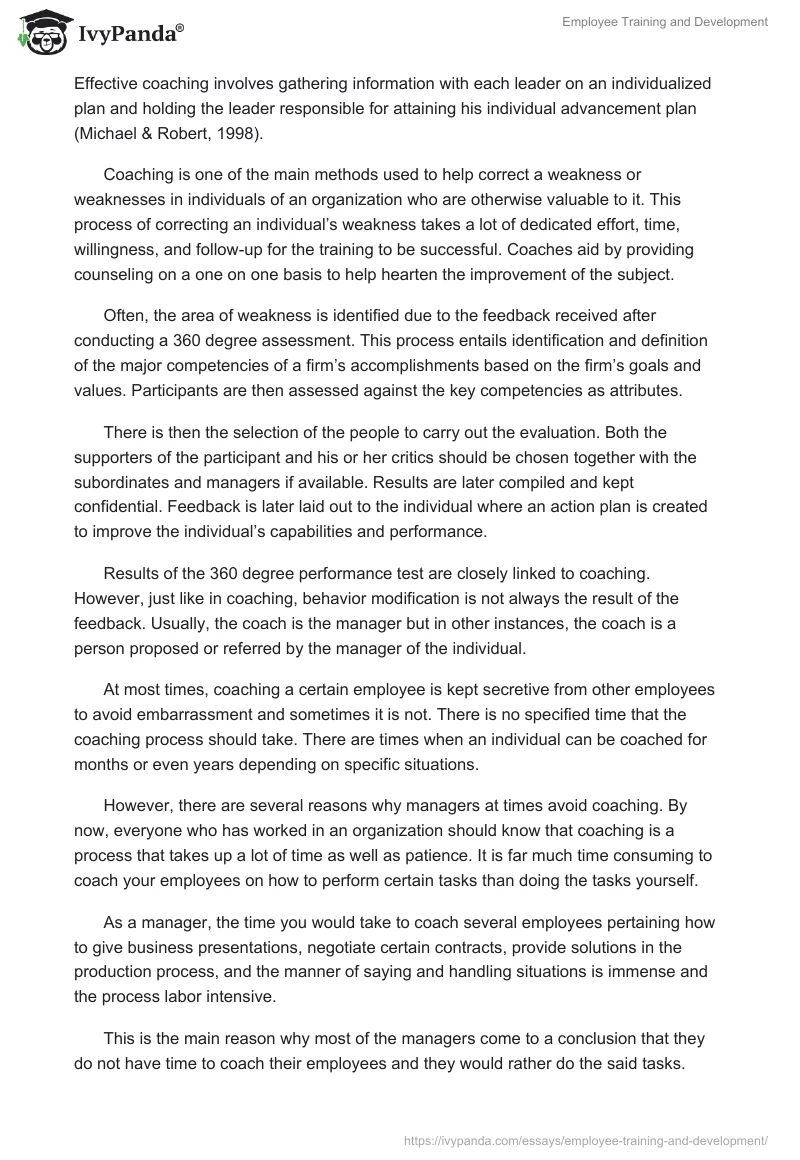Organizations have a need for regular skills assessment. Assessments are important to an organization in several ways. A thoughtful performance assessment procedure helps to create a better working environment and a strong organization. Organizations are interested in increasing the skill or rather proficiency level of their existing employee talent.
In other instances, it is just a routine requirement of developing new skills to have sufficient strength to handle jobs in the future or to enable strategic objectives which are long term. A good example of skill assessment is succession planning (Anchard & Thacker, 2007).
When choosing or training a group of managers, it is important to identify the areas which need improvement while caring not to ignore organizational strengths. Skills assessment of an organization by first measuring its personnel’s skill level helps to improve their ability to finalize on succession training so that they can successfully meet their current and future objectives (Landale, 1999).
By evaluating a wide variety of the workforce in an organization ranging from directors, managers, and supervisors to internal consultants and sales people, an organization is able to put into place individual, team, as well as departmental development efforts for the success of the company. After the skill assessment, employees are now molded to fit the needs of the position, department as well as the organization.
This is made possible because a subset of aptitudes that is most required for maximum performance is selected. Some of these competencies include skills such as attention to detail, personal motivation, analytical thinking, conflict resolution, project co-ordination, ethics, and team building. However, assessments alone are not an effective means of employee development and need to be incorporated with several other tactics of developing employee performance.
The performance of an organization improves with coaching. An appropriate coaching development plan or what others may call a leadership development plan is mostly successful. A firm’s effectiveness is increased by individual and team coaching. Effective coaching involves gathering information with each leader on an individualized plan and holding the leader responsible for attaining his individual advancement plan (Michael & Robert, 1998).
Coaching is one of the main methods used to help correct a weakness or weaknesses in individuals of an organization who are otherwise valuable to it. This process of correcting an individual’s weakness takes a lot of dedicated effort, time, willingness, and follow-up for the training to be successful. Coaches aid by providing counseling on a one on one basis to help hearten the improvement of the subject.
Often, the area of weakness is identified due to the feedback received after conducting a 360 degree assessment. This process entails identification and definition of the major competencies of a firm’s accomplishments based on the firm’s goals and values. Participants are then assessed against the key competencies as attributes.
There is then the selection of the people to carry out the evaluation. Both the supporters of the participant and his or her critics should be chosen together with the subordinates and managers if available. Results are later compiled and kept confidential. Feedback is later laid out to the individual where an action plan is created to improve the individual’s capabilities and performance.
Results of the 360 degree performance test are closely linked to coaching. However, just like in coaching, behavior modification is not always the result of the feedback. Usually, the coach is the manager but in other instances, the coach is a person proposed or referred by the manager of the individual.
At most times, coaching a certain employee is kept secretive from other employees to avoid embarrassment and sometimes it is not. There is no specified time that the coaching process should take. There are times when an individual can be coached for months or even years depending on specific situations.
However, there are several reasons why managers at times avoid coaching. By now, everyone who has worked in an organization should know that coaching is a process that takes up a lot of time as well as patience. It is far much time consuming to coach your employees on how to perform certain tasks than doing the tasks yourself.
As a manager, the time you would take to coach several employees pertaining how to give business presentations, negotiate certain contracts, provide solutions in the production process, and the manner of saying and handling situations is immense and the process labor intensive.
This is the main reason why most of the managers come to a conclusion that they do not have time to coach their employees and they would rather do the said tasks. These managers do not see the appropriate payoff of coaching in future. Another major reason why managers may avoid training their employees is the fact that the company’s culture may dictate that employees be trained only once during hiring, the managers may thereafter assume that they know the manner of doing everything their job requires (Rahim, 1992).
Thirdly, managers may avoid coaching their employees because it requires a certain degree of readiness on the workers part for the process to be effective. For a manager to effectively train and coach employees, he or she has to share his thought process and the exact ways he will use in completing certain tasks and making decisions.
It is daunting to share and reveal all your secret methods of doing things and risk failure if the employees do not work. Results from coaching do not come about immediately but they display themselves systematically. Coaching is all about training or schooling the definite stages of a skill and it is only when these steps are properly understood that success follows.
Leaders think effectively, take initiative, plan strategically, and generate new ideas for the betterment of the organization. The most appropriate methods in training executive leaders are; strategic planning and thinking, scenario planning, analytical information evaluation, proper assessment of factors in the environment that steer an organization’s actions, team leadership, and growth as well as optimizing decision making by using mathematical methods.
The main courses or training methods encompassed in executive leadership include courses like personal leadership development, time and value of money and capital investment, and coaching to develop others. These methods are very effective in developing strong executives (Noe, 2008). One of the main reasons behind this is that executives have it in their power to exercise authority and new ideas unlike employees who are bound to follow certain procedures laid out by the company’s policies.
Therefore if an executive is to undergo proper training in these areas of expertise, then the result will be an organization run by a strong leader and hence smooth operations in the company. This proves the effectiveness of these training methods in training executives to be leaders who can make difficult decisions and significantly evaluate information and resources at their exposure. This will lead to innovations and enhancement of the effectiveness of their employees.
For the past few years, organizations have taken up the idea of internal training and developed universities for facilitating this purpose. This is more advantageous to the company than it is harmful to it. This kind of internal training offers both the employers and the employees advantages which cannot be found in any external training programs. This method ensures that an employee’s skills are enhanced for her readiness in the position she is to take up or for the next promotion.
Internal training does away with the many barriers faced during external training. It reflects a clear and solid image of the knowledge of that organization’s culture because internal training uses actual employees’ experiences of their everyday at work. The demerits also exist since often the organization gets immersed in running of a university to the extent of forgetting or foregoing their basic objectives for which their establishment was created to serve.
References
Anchard, P. N & Thacker, J. W. (2007). Effective Training: Systems, Strategies, and Practices. Oxford: Oxford University Press.
Landale, A. (1999). Gower Handbook of Training and Development. New York: Gower Publishing Ltd.
Michael M. L &Robert W. E. (1998). “HR’s Role In Building Competitive Edge Leaders”. London; Prentice Hall.
Noe, R. A. (2008). Employee Training and Development. New York: McGraw Hill.
Rahim, M. A. (1992). Managing Conflict in Organizations. New York: McGraw-Hill.


